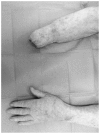Bilateral hand squamous-cells carcinoma in patient affected with non-Hodgkin lymphoma. Case report and literature review
- PMID: 26712073
- PMCID: PMC4732588
- DOI: 10.11138/gchir/2015.36.4.172
Bilateral hand squamous-cells carcinoma in patient affected with non-Hodgkin lymphoma. Case report and literature review
Abstract
Background: Squamous-cell skin cancer is the most frequent tumor in the hand. It occurs on sun-damaged skin, especially in lightskinned individuals with a long history of chronic sun exposure.
Case report: We describe a case of bilateral hand squamous-cell carcinoma in a elderly patient affected with non-Hodgkin's lymphoma, who underwent several non-successful surgical treatment, radiotherapy and at the least, amputation of right hand for rapid clinical evolution after radiotreatment. Available literature on the subject has been reviewed.
Results: In our case, after several non-successful treatment, elective amputation at the distal third of forearm was performed. We reviewed 56 items including books, original articles, reviews, cases report.
Conclusions: Current evidence on treatment of hand squamouscells carcinoma is to perform a first radical surgical treatment in order to avoid recurrence/metastasis and to achieve a safer level of amputation thus increasing the surface area of healthy tissue available for eventually subsequent reconstruction/prosthesization.
Figures




Similar articles
-
[Report of a spinalioma of the right hand].Z Arztl Fortbild (Jena). 1989;83(20):1019-20. Z Arztl Fortbild (Jena). 1989. PMID: 2623903 German. No abstract available.
-
[Squamous cell carcinoma in Dupuytren's disease--a case report].Handchir Mikrochir Plast Chir. 2011 Feb;43(1):54-6. doi: 10.1055/s-0030-1268480. Epub 2011 Jan 11. Handchir Mikrochir Plast Chir. 2011. PMID: 21225571 German.
-
[The Marjolin's ulcer": a malignant and rarely complication after burn trauma of the upper extremity - a case report].Unfallchirurg. 2000 Jan;103(1):68-72. doi: 10.1007/s001130050010. Unfallchirurg. 2000. PMID: 10663108 German.
-
Verrucous carcinoma of the skin: case report with literature review.J BUON. 2009 Jan-Mar;14(1):139-41. J BUON. 2009. PMID: 19365886 Review.
-
Multimodality treatment of squamous cell carcinoma complicating pilonidal disease.Am Surg. 1996 Nov;62(11):922-9. Am Surg. 1996. PMID: 8895714 Review.
Cited by
-
Huriez Syndrome and SCC Risk: A Narrative Review Highlighting Surgical Challenges and Oncologic Considerations.J Clin Med. 2025 Jul 23;14(15):5214. doi: 10.3390/jcm14155214. J Clin Med. 2025. PMID: 40806836 Free PMC article. Review.
-
Tumor necrosis factor receptor 2 may promote the proliferation and drug resistance of Kapras299 and L428 lymphoma cells via the AKT and WNT/β-catenin signaling pathways.Oncol Lett. 2018 Jun;15(6):8847-8852. doi: 10.3892/ol.2018.8396. Epub 2018 Mar 30. Oncol Lett. 2018. PMID: 29928327 Free PMC article.
-
Long-term remission after low dose radiotherapy in patient with extensive squamous cell carcinoma of the hand: A case report.Medicine (Baltimore). 2016 Sep;95(39):e5013. doi: 10.1097/MD.0000000000005013. Medicine (Baltimore). 2016. PMID: 27684868 Free PMC article.
-
A single centre experience of squamous cell carcinoma of the upper limb requiring digital or hand amputation and review of literature.JPRAS Open. 2019 Jan 9;20:43-58. doi: 10.1016/j.jpra.2019.01.001. eCollection 2019 Jun. JPRAS Open. 2019. PMID: 32158871 Free PMC article. Review.
References
-
- Kwa R, Campana K, Moy R. Biology of cutaneous squamous cell carcinoma. Am Acad Dermatol. 1992;26:1–26. - PubMed
-
- Onajin O, Brewer JD. Skin cancer in patients with chronic lymphocytic leukemia and nonhodgkin lymphoma. Clin Adv Hematol Oncol. 2012;10:571–576. - PubMed
-
- Tropet Y, Garnier D, Pageaut G, Vichard P. Spinocellular epithelioma of the hand. Apropos of a diffuse and extensive commissural form. Ann Chir Plast Esthet. 1989;34:162–166. Review. - PubMed
-
- Fink JA, Akelman E. Nonmelanotic malignant skin tumors of the hand. Hand Clin. 1995;11:255–264. - PubMed
Publication types
MeSH terms
LinkOut - more resources
Full Text Sources
Other Literature Sources
Medical
